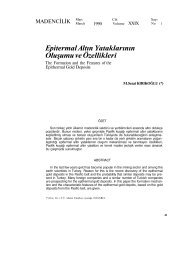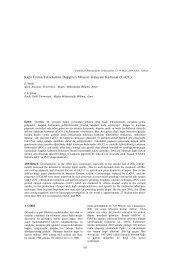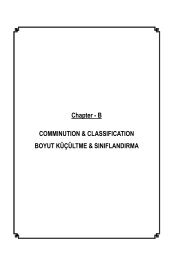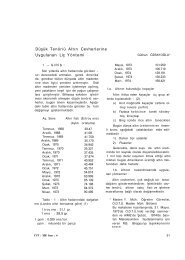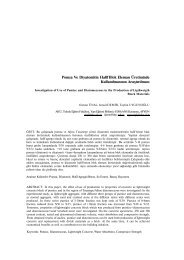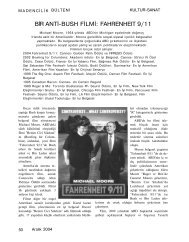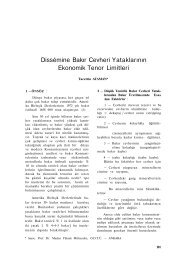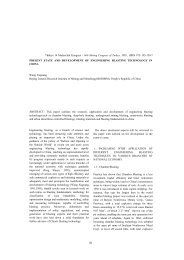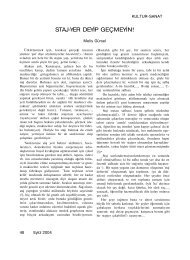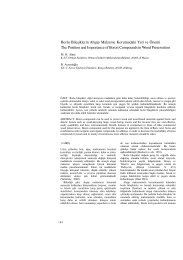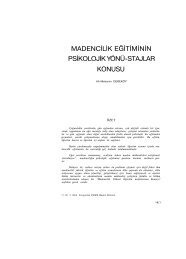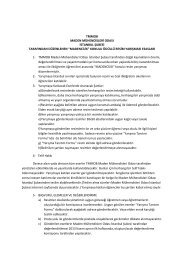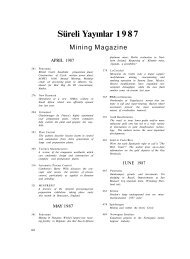A OPEN PIT MINING AÇIK OCAK MADENCİLİĞİ
A OPEN PIT MINING AÇIK OCAK MADENCİLİĞİ
A OPEN PIT MINING AÇIK OCAK MADENCİLİĞİ
You also want an ePaper? Increase the reach of your titles
YUMPU automatically turns print PDFs into web optimized ePapers that Google loves.
through the use of a heuristic model<br />
involving reclamation cost requirements,<br />
linear programming can contribute<br />
worthwhile information to the mine planner.<br />
Caccetta and Keley (1987) declared there are<br />
two basic requirements of mine site<br />
rehabilitation: (i) that the site is safe, stable<br />
and non-eroding at the end of the life of the<br />
mine; and (ii) pollutants such as acidproducing<br />
waste must been buried and been<br />
capped with impermeable material. They<br />
developed a mathematical formulation of the<br />
mined land surface reshaping problem (the<br />
first requirement).<br />
King (1998) shows how rehabilitation and<br />
closure costs of mines impacts the<br />
production rate and cut-off grade strategy for<br />
a mining operation. Rashidinejad et al<br />
(2008a) developed a model for optimum cutoff<br />
grades that not only relies on economical<br />
aspects but also minimizes adverse<br />
environmental impact in the form of acid<br />
mine drainage elimination or mitigation<br />
against the approach of postponing the<br />
restoration/reclamation activities at the end<br />
of the project’s life. Rashidinejad et al<br />
(2008b) developed another useful<br />
methodology that maximizes the profitability<br />
of a mining project and minimizes its<br />
adverse environmental impacts<br />
simultaneously. The acid generating<br />
potential of waste materials and tailings in<br />
each alteration zone can be estimated by<br />
laboratory and in-situ tests. They developed<br />
a modified cut-off grade model with the<br />
concept of elimination or reduction of the<br />
AMD in the original place. Four coefficients<br />
that discriminate between acid generating<br />
and non- acid generating waste material and<br />
tailings incorporated into the Lane’s model<br />
to ensure optimality of cut-off grades.<br />
Gholamnejad (2009) inserted mine<br />
rehabilitation cost into the optimization<br />
process and a new mathematical model<br />
developed based on Lane’s method. Results<br />
of the application of this method show that<br />
considering rehabilitation cost can decrease<br />
the cut-off grade. Dogan et al (2009) studied<br />
the effects of different block size on reserve,<br />
waste amount and distributions of chemical<br />
component such as %CaO, %MgO in quarry<br />
located at Darica, Istanbul. Scenarios with<br />
different block dimensions created by<br />
integrated mining software namely Surpac<br />
6.1 and were compared. Effects of different<br />
blocks on reserve, waste amount, chemical<br />
distribution, and estimation of quality of<br />
cement raw material were determined.<br />
Gholamnejad and Mojahedfar (2010)<br />
developed a mathematical model for<br />
determination of the largest pit with the nonnegative<br />
net profit in the open pit mines.<br />
They declared this strategy can increase the<br />
life of mine which is in accordance to the<br />
sustainable development principals. Craynon<br />
and Karmis (2011) declared that By utilizing<br />
geographic information system (GIS) tools<br />
to evaluate available data on environmental<br />
and social resources, the regulatory barriers<br />
which prevent operations from incorporating<br />
ecological and other sustainable<br />
development concerns into coal mine<br />
sustainability performance were identified.<br />
By analysis of the on-the-ground issues<br />
related to sustainability, the key parameters<br />
to be incorporated into an optimized coal<br />
mine design in Appalachia are discussed<br />
along with possible changes to the<br />
regulatory framework that would enhance<br />
incorporation of sustainability into coal mine<br />
design. Ataeepour et al (2012) developed a<br />
mathematical model for determination of<br />
UPL with simultaneous maximization of<br />
profit and ore content. They introduce a new<br />
characteristic of deposit that named<br />
“potential of extension” that is a guide for<br />
designer for UPL selection on base of<br />
resource efficiency and profitability.<br />
2 UPL DETERMINATION ON BASE<br />
OF SUSTAINABLE DEVELOPMENT<br />
ASPECTS<br />
2.1 General description<br />
As above-mentioned, there general<br />
method for UPL determination is on base of<br />
profit aspect and there is no consideration on<br />
sustainable development aspects. We try to<br />
develop a method for captioned subject.<br />
106



